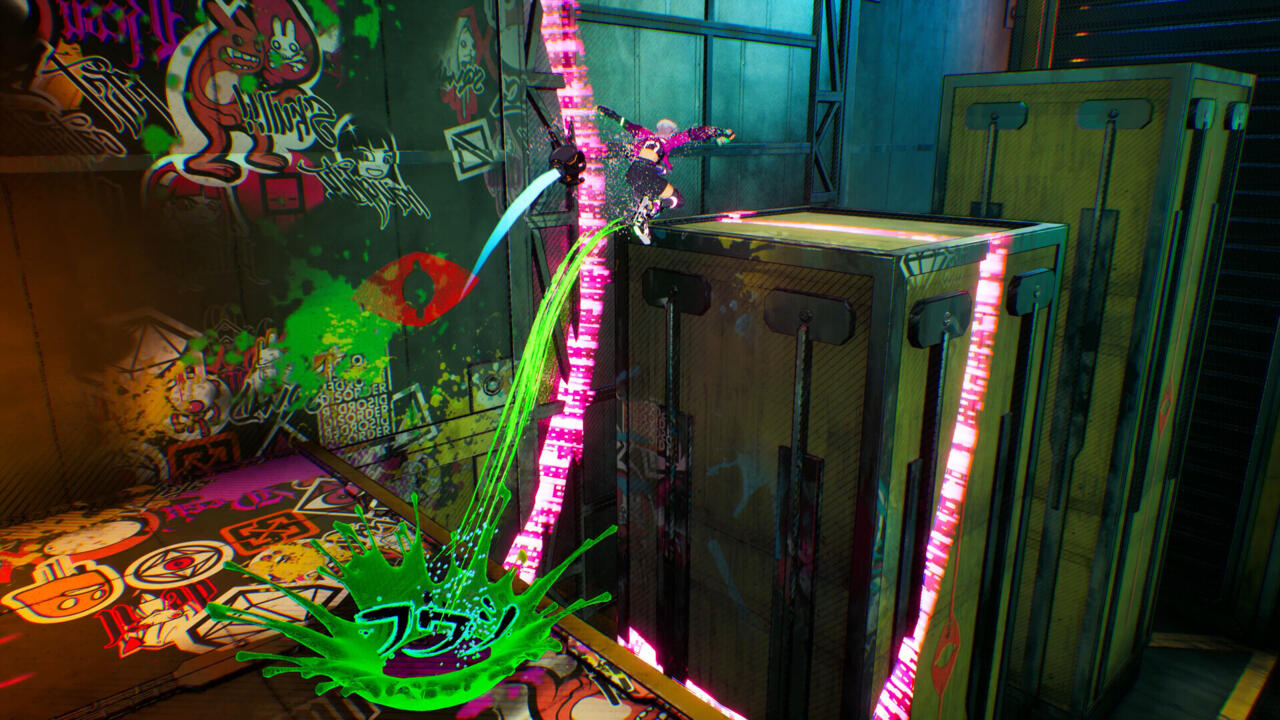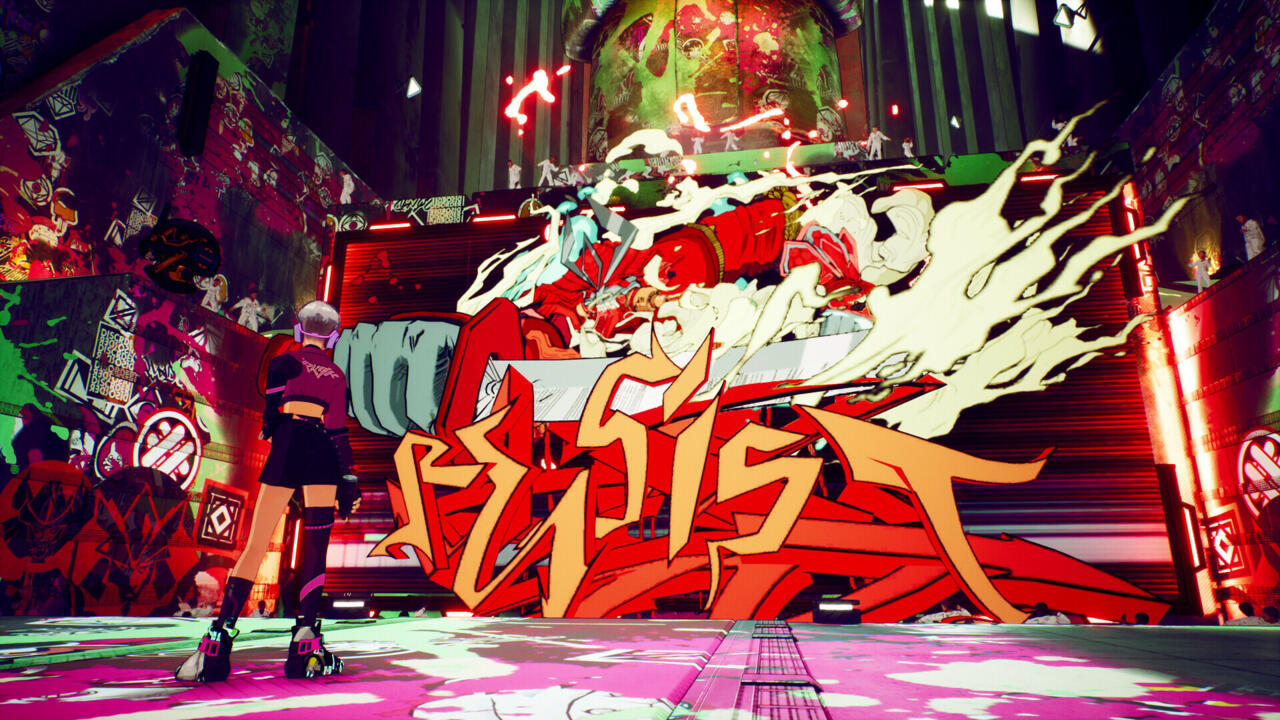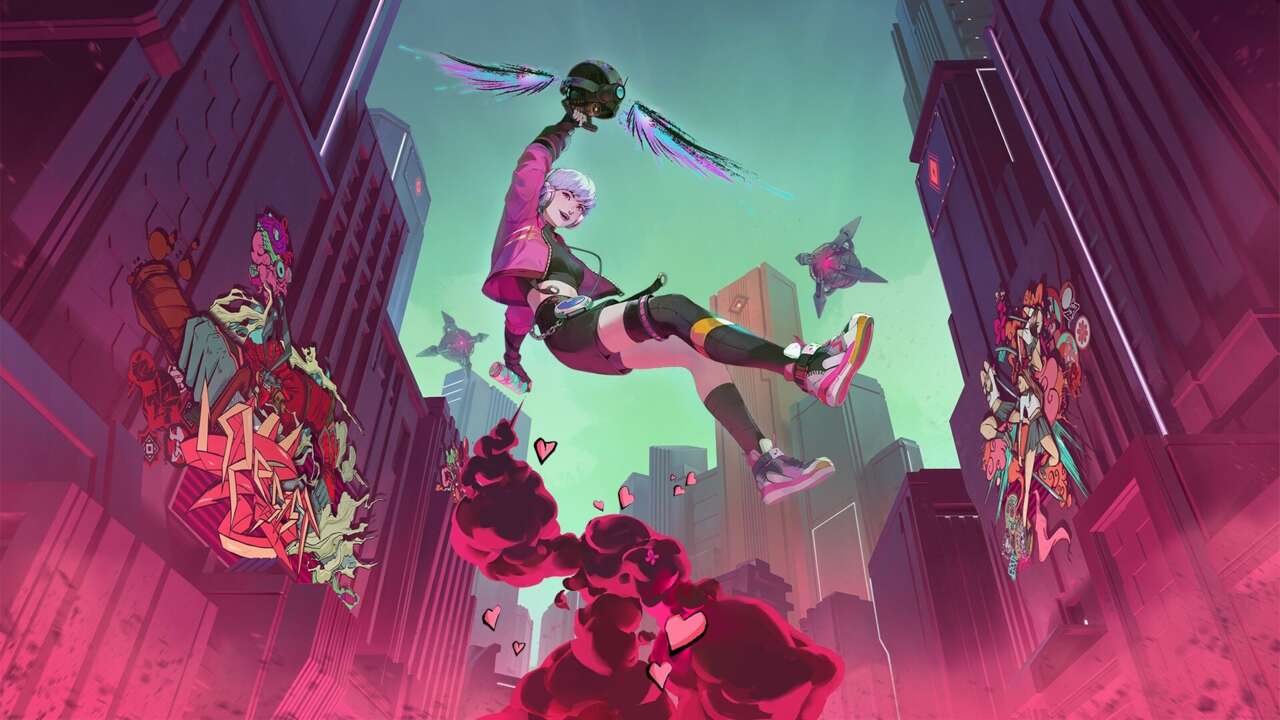There’s initially something so tantalizing about RKGK / Rakugaki’s bold usage of color in its anime-inspired art style. From the jump, the game’s story seems rambunctious and absurd in the best possible way, accompanied by gameplay where split-second decisions reward your well-timed jumps and dashes with brief explosions of color. As the game continues, however, the aesthetic of each level begins to run together and the underlying narrative loses steam, leaving only the platforming challenges to evolve in any meaningful way. So even though the story doesn’t leave a lasting impression, your acrobatic escapades through each level do, carrying the game to gratifying heights.
In RKGK, you play as street artist-turned-rebel Valah, who is set on taking her city back from Mr. Buff, a rotund megalomaniac set on enslaving the populace with hypnotizing billboard screens and an army of robots. With spray paint cans in hand, Valah does battle with Mr. Buff’s robotic minions in an assortment of third-person 3D platforming levels, returning to her home base between each mission to talk with her allies or switch outfits.
Each level of RKGK is a self-contained gauntlet of shifting platforms, explosive traps, twisting rails, and breakable containers that Valah must double-jump over, dash past, grind through, or smash. Enemies populate each level but are easily overcome with a quick spray of Valah’s paint–it’s not all that challenging or rewarding to take them down. Some provide an additional challenge by shielding themselves or releasing area-of-effect attacks, but nothing that comes close to stopping Valah, even on the harder difficulty where she has less health.
But the name of the game for each level is speed, not combat. Your performance for each level is graded, with completion time affecting the curve most of all–it’s clear enemies are meant to be a speed bump, not a combat challenge. Chasing that faster time is the crux of RKGK, and it’s delightful to replay levels in hopes of uncovering hidden shortcuts or figuring out faster ways to chain together enough platforming combos without Valah being hit to unlock a speed boost that rockets her forward. Deducing a new way in which to shave off a crucial handful of seconds to earn a better letter grade feels like a victory over the robotic minions in itself.
Even RKGK’s boss battles are structured around platforming, prioritizing Valah’s positioning and timing until the boss opens itself up to an attack. It’s not the most exciting way to take down the hulking constructs that impede Valah’s way, however, which lessens the thrill of overcoming them–hiding behind an obstacle and waiting for the boss to stupidly ram into it for the third time just isn’t as thrilling as performing a death-defying leap to shave some time off a level, for example.
Valah’s movements possess an exuberant sense of speed without sacrificing control–whenever I fell off a platform or missed a jump, the fault was mine. The build-up of the platforming challenges is a rewarding climb as well. As Valah continues through the game and reaches later levels, she encounters faster-moving platforms, flame-spouting traps, and increasingly obtrusive obstacles, but RKGK never piles on multiple new elements at a time. Instead, they are typically introduced in a vacuum, forcing you to contend with the new element one or two times, before then finding ways to weave it into aspects of level design you’ve encountered, subsequently remaking an old obstacle into a new challenge that you already have an inkling of how to overcome.

This method of level design ensures RKGK has a steady momentum when it comes to progression. Even on the harder of the two difficulties, you’re rarely stymied for long, allowing you to complete each level in a matter of minutes and move on to the next stage if you want. Every level hides secrets off the beaten path and a few contain a handful of shortcuts, incentivizing you to replay them to earn a higher grade and unlock more rewards, which can then be spent to buy cosmetics for Valah, like outfits and paint colors.
This structure centered around replayability does help alleviate the shortcomings in RKGK’s story, which is bland and shallow. Valah is not an easy protagonist to relate to, spouting quirky action-movie one-liners and wanting to stand up to the big bad but not really existing beyond those general characterizations. The story rushes through her battle with Mr. Buff, never quite delving into either character’s motivations or rivalry in an intriguing way. Midway through the game, I had completely checked out of its story, solely incentivized to keep going to enjoy the well-designed levels and increasingly complex platforming challenges.
The blandness of the narrative bleeds a little bit into the aesthetics of the levels, too. Though they are designed well and each presents a handful of obstacles and challenges unique to it, a huge swath of the levels that Valah parkours through all visually look the same. Presumably, this is to go along with Mr. Buff’s motivations to make everything look as identical and lifeless as the robots he commands, but in practice, this translates into dozens of levels that all bleed together in my mind. This doesn’t hurt the moment-to-moment of RKGK’s gameplay but does impact the overall game’s memorability and further detracts from the narrative elements of the world. It’s hard to care about a world so same-y, and I wish Valah’s efforts to clear each stage and remind the populace about their home city’s uniqueness was translated into the game so that I could see it, too.

You see a snippet of something like this whenever Valah happens across one of the hypnotic billboards in the world, which she can paint over for extra points if she’s collected enough paint throughout the stage. When she does so, you’re presented with beautiful works of art that pull inspiration from both Japanese anime and Mexico’s graffiti culture, hinting at what type of world Valah did live in before it all became red and gray. They’re always awe-inspiring to see, and Valah suddenly painting something new quickly became one of the things I most looked forward to while playing through each level. These instances are rare, however, hiding away one of the most stunning aspects of the game.
RKGK / Rakugaki is a fun debut for Wabisabi Games, incorporating an incredible anime-inspired art style into an approachable 3D platformer. Same-y looking environments, disappointing boss battles, and a bland story all make it hard to connect to the narrative elements of the game, but the gameplay is sound and the level design is rewardingly challenging. Even though the story is forgettable, my desire to further master my timing and precision in my quest to get better and better completion times is, for now, continuing to bring me back.
